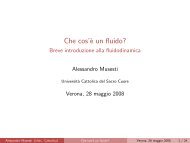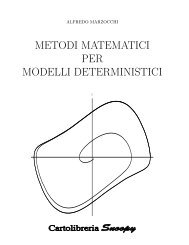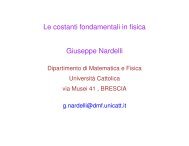- Page 2 and 3: JürgenH.Gross Mass Spectrometry
- Page 4 and 5: Dr. Jürgen H. Gross Institute of O
- Page 8 and 9: Table of Contents Contents.........
- Page 10 and 11: 3.4.2 Multiple Isotopic Composition
- Page 12 and 13: XIII 6.2.3 �-Cleavage of Non-Symm
- Page 14 and 15: XV 8.3 Field Emitters..............
- Page 16 and 17: XVII 11.2.2 ESI with Modified Spray
- Page 18 and 19: 1 Introduction Mass spectrometry is
- Page 20 and 21: 1.2 What Is Mass Spectrometry? 3 ta
- Page 22 and 23: 1.2 What Is Mass Spectrometry? 5 ev
- Page 24 and 25: 1.3 Filling the Black Box 1.4 Termi
- Page 26 and 27: 1.5 Units, Physical Quantities, and
- Page 28 and 29: 15. Quayle, A. Recollections of MS
- Page 30 and 31: 2 Gas Phase Ion Chemistry The mass
- Page 32 and 33: 2.2.1 Electron Ionization 2.2 Ioniz
- Page 34 and 35: 2.2 Ionization 17 fore, they exhibi
- Page 36 and 37: 2.3 Vertical Transitions 19 Fig. 2.
- Page 38 and 39: 2.5 Internal Energy and the Further
- Page 40 and 41: 2.5 Internal Energy and the Further
- Page 42 and 43: 2.5 Internal Energy and the Further
- Page 44 and 45: 2.6 Rate Constants from QET 27 Note
- Page 46 and 47: 2.6 Rate Constants from QET 29 to n
- Page 48 and 49: 2.6 Rate Constants from QET 31 Fig.
- Page 50 and 51: 2.7 Time Scale of Events 33 Fig. 2.
- Page 52 and 53: 2.7 Time Scale of Events 35 flat-to
- Page 54 and 55: 2.8 Activation Energy of the Revers
- Page 56 and 57:
2.8 Activation Energy of the Revers
- Page 58 and 59:
2.9 Isotope Effects 41 this species
- Page 60 and 61:
2.9 Isotope Effects 43 Fig. 2.17. C
- Page 62 and 63:
2.10 Determination of Ionization En
- Page 64 and 65:
2.10 Determination of Ionization En
- Page 66 and 67:
2.10 Determination of Ionization En
- Page 68 and 69:
2.10 Determination of Ionization En
- Page 70 and 71:
2.12 Tandem Mass Spectrometry 2.12
- Page 72 and 73:
2.12 Tandem Mass Spectrometry 55 Fi
- Page 74 and 75:
2.12 Tandem Mass Spectrometry 57 ac
- Page 76 and 77:
2.12.2.3 Electron Capture Dissociat
- Page 78 and 79:
Reference List 1. Porter, C.J.; Bey
- Page 80 and 81:
58. Gross, J.H.; Veith, H.J. Unimol
- Page 82 and 83:
actions in the Gas Phase. Int. J. M
- Page 84 and 85:
3 Isotopes Mass spectrometry is bas
- Page 86 and 87:
3.1.2.3 X-1 Elements 3.1 Isotopic C
- Page 88 and 89:
3.1 Isotopic Classification of the
- Page 90 and 91:
3.1 Isotopic Classification of the
- Page 92 and 93:
P P M �1 M � c � � w� �
- Page 94 and 95:
3.2 Calculation of Isotopic Distrib
- Page 96 and 97:
For halogens the isotopic peaks are
- Page 98 and 99:
3.2 Calculation of Isotopic Distrib
- Page 100 and 101:
3.2 Calculation of Isotopic Distrib
- Page 102 and 103:
3.2.8.2 Handling of Isotopic Patter
- Page 104 and 105:
3.2 Calculation of Isotopic Distrib
- Page 106 and 107:
3.3 High-Resolution and Accurate Ma
- Page 108 and 109:
3.3.2.3 Deltamass 3.3 High-Resoluti
- Page 110 and 111:
3.3 High-Resolution and Accurate Ma
- Page 112 and 113:
3.3 High-Resolution and Accurate Ma
- Page 114 and 115:
R= 500 0.1 u 1 u 3.3 High-Resolutio
- Page 116 and 117:
el. int. [%] 3.3 High-Resolution an
- Page 118 and 119:
3.3 High-Resolution and Accurate Ma
- Page 120 and 121:
3.3 High-Resolution and Accurate Ma
- Page 122 and 123:
3.4 Interaction of Resolution and I
- Page 124 and 125:
3.4 Interaction of Resolution and I
- Page 126 and 127:
Reference List 109 Example: The EI
- Page 128 and 129:
4 Instrumentation “A modern mass
- Page 130 and 131:
4.2 Time-of-Flight Instruments 113
- Page 132 and 133:
4.2 Time-of-Flight Instruments 115
- Page 134 and 135:
4.2 Time-of-Flight Instruments 117
- Page 136 and 137:
4.2 Time-of-Flight Instruments 119
- Page 138 and 139:
4.2 Time-of-Flight Instruments 121
- Page 140 and 141:
4.2 Time-of-Flight Instruments 123
- Page 142 and 143:
4.2 Time-of-Flight Instruments 125
- Page 144 and 145:
� � tan �1 �Vtof � v �1
- Page 146 and 147:
4.2.7.1 Tandem MS in a ReTOF Analyz
- Page 148 and 149:
4.3 Magnetic Sector Instruments 131
- Page 150 and 151:
4.3.2.2 Direction Focusing by the M
- Page 152 and 153:
e 4.3 Magnetic Sector Instruments 1
- Page 154 and 155:
4.3 Magnetic Sector Instruments 137
- Page 156 and 157:
4.3 Magnetic Sector Instruments 139
- Page 158 and 159:
4.3 Magnetic Sector Instruments 141
- Page 160 and 161:
4.3.6.4 Additional Linked Scan Func
- Page 162 and 163:
4.4 Linear Quadrupole Instruments 1
- Page 164 and 165:
4.4 Linear Quadrupole Instruments 1
- Page 166 and 167:
4.4 Linear Quadrupole Instruments 1
- Page 168 and 169:
4.4.3.1 Performance of Cylindrical
- Page 170 and 171:
4.4 Linear Quadrupole Instruments 1
- Page 172 and 173:
4.5 Three-Dimensional Quadrupole Io
- Page 174 and 175:
4.5 Three-Dimensional Quadrupole Io
- Page 176 and 177:
4.5.3.2 Mass-Selective Instability
- Page 178 and 179:
4.5 Three-Dimensional Quadrupole Io
- Page 180 and 181:
4.5 Three-Dimensional Quadrupole Io
- Page 182 and 183:
4.6 Fourier Transform Ion Cyclotron
- Page 184 and 185:
4.6 Fourier Transform Ion Cyclotron
- Page 186 and 187:
4.6 Fourier Transform Ion Cyclotron
- Page 188 and 189:
4.6 Fourier Transform Ion Cyclotron
- Page 190 and 191:
4.7 Hybrid Instruments 173 Fig. 4.5
- Page 192 and 193:
4.8 Detectors 4.8 Detectors 175 The
- Page 194 and 195:
4.8 Detectors 177 Fig. 4.58. Schema
- Page 196 and 197:
4.8 Detectors 179 rupole mass analy
- Page 198 and 199:
4.9 Vacuum Technology 181 hales int
- Page 200 and 201:
trometer With Pulsed Extraction. J.
- Page 202 and 203:
Single-Stage Reflectrons. Org. Mass
- Page 204 and 205:
upole Mass Spectrometer for High- T
- Page 206 and 207:
on Mass Resolution. Anal. Chem. 199
- Page 208 and 209:
208. Wu, Z.; Hendrickson, C.L.; Rod
- Page 210 and 211:
5 Electron Ionization The use of el
- Page 212 and 213:
5.1 Behavior of Neutrals Upon Elect
- Page 214 and 215:
5.1 Behavior of Neutrals Upon Elect
- Page 216 and 217:
5.1 Behavior of Neutrals Upon Elect
- Page 218 and 219:
5.2 Electron Ionization Ion Sources
- Page 220 and 221:
5.2 Electron Ionization Ion Sources
- Page 222 and 223:
5.2 Electron Ionization Ion Sources
- Page 224 and 225:
Table 5.1. Sample introduction syst
- Page 226 and 227:
5.3.1.2 Sample Vials 5.3 Sample Int
- Page 228 and 229:
5.3 Sample Introduction 211 In eith
- Page 230 and 231:
5.3 Sample Introduction 213 inlet s
- Page 232 and 233:
5.4.2 Reconstructed Ion Chromatogra
- Page 234 and 235:
5.5 Mass Analyzers for EI 5.6 Analy
- Page 236 and 237:
8. Schröder, E. Massenspektrometri
- Page 238 and 239:
58. Basile, F.; Beverly, M.B.; Voor
- Page 240 and 241:
6 Fragmentation of Organic Ions and
- Page 242 and 243:
6.1 Cleavage of a Sigma-Bond 225 Fr
- Page 244 and 245:
6.1 Cleavage of a Sigma-Bond 227 'E
- Page 246 and 247:
6.2 Alpha-Cleavage 229 Note: The de
- Page 248 and 249:
6.2 Alpha-Cleavage 231 over the for
- Page 250 and 251:
6.2 Alpha-Cleavage 233 m/z 15. If t
- Page 252 and 253:
6.2.4.2 Differentiation Between Car
- Page 254 and 255:
6.2 Alpha-Cleavage 237 Table 6.5. R
- Page 256 and 257:
6.2 Alpha-Cleavage 239 Nitrogen rul
- Page 258 and 259:
6.2 Alpha-Cleavage 241 ions are hig
- Page 260 and 261:
6.2 Alpha-Cleavage 243 Fig. 6.9. EI
- Page 262 and 263:
6.2.7.1 Propyl Loss of Cyclohexanon
- Page 264 and 265:
6.3 Distonic Ions 6.3.1 Definition
- Page 266 and 267:
6.4 Benzylic Bond Cleavage 249 tral
- Page 268 and 269:
6.4 Benzylic Bond Cleavage 251 Note
- Page 270 and 271:
6.4 Benzylic Bond Cleavage 253 (Fig
- Page 272 and 273:
6.5 Allylic Bond Cleavage 255 Care
- Page 274 and 275:
6.5 Allylic Bond Cleavage 257 stere
- Page 276 and 277:
6.6. Cleavage of Non-Activated Bond
- Page 278 and 279:
6.6. Cleavage of Non-Activated Bond
- Page 280 and 281:
6.6.4 Recognition of the Molecular
- Page 282 and 283:
6.7 McLafferty Rearrangement 265 ra
- Page 284 and 285:
6.7 McLafferty Rearrangement 267 to
- Page 286 and 287:
6.7 McLafferty Rearrangement 269 Ex
- Page 288 and 289:
6.7 McLafferty Rearrangement 271 Fi
- Page 290 and 291:
6.7 McLafferty Rearrangement 273 ev
- Page 292 and 293:
6.7 McLafferty Rearrangement 275 Ex
- Page 294 and 295:
6.8 Retro-Diels-Alder Reaction 277
- Page 296 and 297:
6.8.3 Is the RDA Reaction Stepwise
- Page 298 and 299:
6.9 Elimination of Carbon Monoxide
- Page 300 and 301:
6.9 Elimination of Carbon Monoxide
- Page 302 and 303:
6.9.3 Fragmentation of Arylalkyleth
- Page 304 and 305:
O Cl H +. O Cl H H +. 6.9 Eliminati
- Page 306 and 307:
6.10 Thermal Degradation Versus Ion
- Page 308 and 309:
6.10 Thermal Degradation Versus Ion
- Page 310 and 311:
6.11 Alkene Loss from Onium Ions 29
- Page 312 and 313:
6.11 Alkene Loss from Onium Ions 29
- Page 314 and 315:
6.11 Alkene Loss from Onium Ions 29
- Page 316 and 317:
6.11 Alkene Loss from Onium Ions 29
- Page 318 and 319:
6.12 Ion-Neutral Complexes 301 �-
- Page 320 and 321:
6.12.4 Ion-Neutral Complexes of Rad
- Page 322 and 323:
6.13.1 Ortho Elimination from Molec
- Page 324 and 325:
6.13 Ortho Elimination (Ortho Effec
- Page 326 and 327:
6.13 Ortho Elimination (Ortho Effec
- Page 328 and 329:
6.14 Heterocyclic Compounds 6.14 He
- Page 330 and 331:
6.14 Heterocyclic Compounds 313 Fig
- Page 332 and 333:
6.14.2 Aromatic Heterocyclic Compou
- Page 334 and 335:
6.14.2.2 Loss of Hydrogen Isocyanid
- Page 336 and 337:
6.15 Guidelines for the Interpretat
- Page 338 and 339:
5. McLafferty, F.W.; Turecek, F. In
- Page 340 and 341:
tions: an Account of Mechanistic Co
- Page 342 and 343:
[R'CO2H2] + in the Mass Spectra of
- Page 344 and 345:
146. Budzikiewicz, H.; Bold, P. A M
- Page 346 and 347:
Acid Derivatives. Z. Naturforsch.,
- Page 348 and 349:
7 Chemical Ionization Mass spectrom
- Page 350 and 351:
7.2 Chemical Ionization by Protonat
- Page 352 and 353:
7.2 Chemical Ionization by Protonat
- Page 354 and 355:
7.2 Chemical Ionization by Protonat
- Page 356 and 357:
7.2 Chemical Ionization by Protonat
- Page 358 and 359:
7.3 Charge Exchange Chemical Ioniza
- Page 360 and 361:
Table 7.2. Compilation of CE-CI rea
- Page 362 and 363:
7.4 Electron Capture 7.4 Electron C
- Page 364 and 365:
7.4 Electron Capture 347 Example: C
- Page 366 and 367:
7.5.1 Desorption Chemical Ionizatio
- Page 368 and 369:
7.7 Mass Analyzers for CI Reference
- Page 370 and 371:
48. Schneider, B.; Budzikiewicz, H.
- Page 372 and 373:
8 Field Ionization and Field Desorp
- Page 374 and 375:
8.2 FI and FD Ion Source 8.2 FI and
- Page 376 and 377:
8.3 Field Emitters 359 on emitters
- Page 378 and 379:
8.3 Field Emitters 361 Note: To app
- Page 380 and 381:
8.4 FI Spectra 8.4 FI Spectra 363 F
- Page 382 and 383:
8.5 FD Spectra 365 Note: For the re
- Page 384 and 385:
8.5 FD Spectra 367 Fig. 8.12. Schem
- Page 386 and 387:
8.5 FD Spectra 369 emphasizes the r
- Page 388 and 389:
8.5.3 FD-MS of Ionic Analytes 8.5 F
- Page 390 and 391:
8.5 FD Spectra 373 shows significan
- Page 392 and 393:
Table 8.2. Ions formed by FD Method
- Page 394 and 395:
17. Sammons, M.C.; Bursey, M.M.; Wh
- Page 396 and 397:
Spectrometry for the Analysis of Po
- Page 398 and 399:
9 Fast Atom Bombardment When partic
- Page 400 and 401:
9.1 Ion Sources for FAB and LSIMS 3
- Page 402 and 403:
9.2 Ion Formation in FAB and LSIMS
- Page 404 and 405:
9.3 FAB Matrices 387 It has been es
- Page 406 and 407:
9.4 Applications of FAB-MS 389 may
- Page 408 and 409:
9.4 Applications of FAB-MS 391 Fig.
- Page 410 and 411:
9.4 Applications of FAB-MS 393 tryp
- Page 412 and 413:
9.4 Applications of FAB-MS 395 ties
- Page 414 and 415:
9.4 Applications of FAB-MS 397 More
- Page 416 and 417:
9.4 Applications of FAB-MS 399 Note
- Page 418 and 419:
9.6 252Californium Plasma Desorptio
- Page 420 and 421:
Table 9.1. Ions formed by FAB/LSIMS
- Page 422 and 423:
Analysis of High-Purity Materials.
- Page 424 and 425:
78. Busch, K.L. Chemical Noise in-M
- Page 426 and 427:
126. Boryak, O.A.; Stepanov, I.O.;
- Page 428 and 429:
10 Matrix-Assisted Laser Desorption
- Page 430 and 431:
10.2 Ion Formation 10.2 Ion Formati
- Page 432 and 433:
10.2 Ion Formation 415 Note: MALDI
- Page 434 and 435:
10.3 MALDI Matrices 417 MALDI, the
- Page 436 and 437:
10.4 Sample Preparation 419 formed
- Page 438 and 439:
10.4 Sample Preparation 421 [M-2H+2
- Page 440 and 441:
10.4 Applications of LDI 423 Fig. 1
- Page 442 and 443:
10.5 Applications of MALDI 10.5.1 M
- Page 444 and 445:
10.5.2 Fingerprints by MALDI-MS 10.
- Page 446 and 447:
10.5 Applications of MALDI 429 Exam
- Page 448 and 449:
10.7 Atmospheric Pressure MALDI 431
- Page 450 and 451:
10.8.3 Types of Ions in LDI and MAL
- Page 452 and 453:
25. Overberg, A.; Karas, M.; Bahr,
- Page 454 and 455:
From Human Milk. J. Mass Spectrom.
- Page 456 and 457:
Mammalian Thioredoxin Reductase: Im
- Page 458 and 459:
11 Electrospray Ionization Electros
- Page 460 and 461:
11.1 Development of ESI and Related
- Page 462 and 463:
11.2 Ion Sources for ESI 445 or a c
- Page 464 and 465:
11.2.3 Nano-Electrospray 11.2 Ion S
- Page 466 and 467:
11.2 Ion Sources for ESI 449 spray
- Page 468 and 469:
11.2.5 Skimmer CID 11.3 Ion Formati
- Page 470 and 471:
11.3 Ion Formation 453 field streng
- Page 472 and 473:
11.4 Charge Deconvolution 455 Fig.
- Page 474 and 475:
11.4 Charge Deconvolution 457 Examp
- Page 476 and 477:
11.4 Charge Deconvolution 459 In ca
- Page 478 and 479:
11.4 Charge Deconvolution 461 Fig.
- Page 480 and 481:
11.5 Applications of ESI 463 Fig. 1
- Page 482 and 483:
11.6 Atmospheric Pressure Chemical
- Page 484 and 485:
11.8 General Characteristics of ESI
- Page 486 and 487:
8. Fuerstenau, S.D.; Benner, W.H.;
- Page 488 and 489:
Electrophoresis-Mass Spectrometry.
- Page 490 and 491:
114. Ebeling, D.D.; Scalf, M.; West
- Page 492 and 493:
12 Hyphenated Methods The analysis
- Page 494 and 495:
12.1 General Properties of Chromato
- Page 496 and 497:
12.1 General Properties of Chromato
- Page 498 and 499:
12.1 General Properties of Chromato
- Page 500 and 501:
12.2 Gas Chromatography-Mass Spectr
- Page 502 and 503:
elative intensity relative intensit
- Page 504 and 505:
12.3 Liquid Chromatography-Mass Spe
- Page 506 and 507:
12.3 Tandem Mass Spectrometry 489 T
- Page 508 and 509:
Reference List 491 Classically, hig
- Page 510 and 511:
During GC-MS. Anal. Chem. 1973, 45,
- Page 512 and 513:
Appendix 1 Isotopic Composition of
- Page 514 and 515:
1 Isotopic Composition of the Eleme
- Page 516 and 517:
1 Isotopic Composition of the Eleme
- Page 518 and 519:
2 Carbon Isotopic Patterns 501 Pt c
- Page 520 and 521:
4 Chlorine and Bromine Isotopic Pat
- Page 522 and 523:
6 Frequent Impurities Table A.4. Re
- Page 524 and 525:
508 Subject Index C 252 Californium
- Page 526 and 527:
510 Subject Index ion source/interf
- Page 528 and 529:
512 Subject Index ionization cross
- Page 530 and 531:
514 Subject Index solvent-free prep
- Page 532 and 533:
516 Subject Index RDA see retro-Die
- Page 534:
518 Subject Index W weight-average








